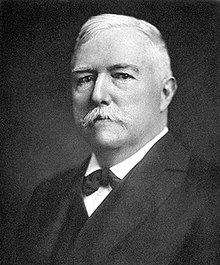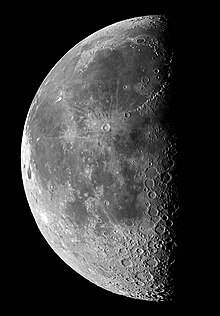Astrophotography

The astrophotography includes those methods of photography , which stars , planets, nebula and other celestial bodies displayed in visible light and are permanently stored on various media (chemically or electronically).
With their help you can also display objects that are too faint for visual observation. In contrast to the eye, photographic emulsions (films, plates ) or electro-optical image sensors can collect the effects of light during long exposure times. This advantage comes from a. for low surface brightness (galaxies, gas and dust nebulae, cometary tails) to wear. The objects of astrophotography range from the bodies of the solar system (planets, asteroids, comets, meteors, etc.) to objects in our Milky Way (stars, star clusters, nebulae) to the most distant galaxies and galaxy clusters.
In general, the sky recordings have to be adapted to the daily rotation of the starry sky in order to achieve a point-like image of the stars instead of a trace record . For this purpose, the telescope or camera is fitted with an equatorial mount , one axis of which is precisely aligned with the celestial pole (extended earth axis). The tracking can be done manually or by machine, it is monitored with a guide telescope .
Astrophotography techniques are also used in satellite geodesy , ballistics and space travel to determine the orbit of missiles .
Important tasks of astrophotography
The special cameras used in astronomy are called astrographs . They allow you to photographic plates of large fields starry sky or selected star fields to capture and
- carry out astrometric position determinations ( star locations , self-movements ),
- precisely measure the brightness of many stars (see photometry ),
- or to study the spectra of stars and other objects ( spectrography ).
- Reliable archiving enables newly discovered celestial bodies to be found even after decades and phenomena to be measured again.
Photographic Archives
One of the world's largest photo plate archives is owned by the observatory founded by Cuno Hoffmeister in 1925 in Sonneberg, Thuringia . It comprises around 300,000 sky recordings that document the astronomical events in the area of the northern Milky Way over almost 70 years and on which more than 11,000 variable stars as well as numerous novae and asteroids have been discovered so far .
In 1948, the 48-inch Schmidt camera (now known as the Oschin Telescope ) went into operation on Mount Palomar . The Palomar Observatory Sky Survey ("POSS") was carried out with the world's largest astrograph , probably the most important sky survey of the 20th century.
The archive of the Harvard College Observatory contains over 500,000 astrophotographic plates from the period from 1885 to 1989. In 1965 a project began there for which work with the Sonneberg photo plate archive as part of the "long-term research program" Sonneberger Felderplan (Field patrol ) and Sonneberger Sky patrol for the observation and photographic exploration of the changeable stars, meteors and extragalactic objects were role models. These projects of the "Sternwarte Sonneberg" and the "Harvard College Observatory" were supposed to record the most complete documentation of the changes in the northern sky. For this purpose, six specially constructed astrographs (named Damon cameras after the sponsor ) were used on “Mount Palomar”, each of which recorded a field of view of 30 ° × 40 ° in three defined colors on 20 cm × 25 cm plates . The aim was to obtain and archive uniform and therefore comparable recordings over decades. This program was canceled in 1989.
Astrophotography places high demands on the lenses and (given the mostly long exposure times) on the telescope drive. If these are met - today mostly with electronic control - long-exposure images of extremely faint objects such as distant galaxies or fine gas nebulae can be obtained.
story
Already months before the publication of his photographic process (1838), Louis Daguerre is said to have taken a picture of the moon - this would be the first astrophotography in the world. The photos of the moon by John William Draper in 1840, who also recorded the first spectrogram of the sun in 1843, became famous. In April 1845, Léon Foucault and Hippolyte Fizeau took the first photo of the sun; on her daguerreotype with a diameter of 12 cm, sunspots were clearly visible.
In 1850 a fixed star - Vega - was recorded for the first time at Harvard College Observatory by John Adams Whipple ; However, the mounting of the telescope used was not precise enough for the exposure time of 100 seconds. After improvements, a good image of the double star system Alkor and Mizar succeeded in 1857 - now using a collodion plate - which could be used for a precise determination of the relative positions. During the solar eclipse in July 1860, the question of whether protuberances actually represent solar outbreaks could be clarified photographically . In 1872 Henry Draper took the first picture of a star spectrum - again it was Vega, the brightest star in the northern sky. Jules Janssen took photos of the passage of Venus in 1874 ; On his recordings, even the granulation of the sun's surface could be seen, which was previously only known from a few visual observations. On December 22, 1891, Max Wolf was the first astronomer to find a minor planet using photographic methods.
On September 30, 1880, Henry Draper succeeded for the first time (on bromide silver emulsion) in recording a gas nebula in the Milky Way, namely the Orion Nebula . The first galaxy followed in 1884 with the Andromeda Nebula by Andrew Ainslie Common ; 15 years later Julius Scheiner recorded the first spectrum from her in Potsdam.
With the constant improvement of the recording material, the idea of ground, celestial atlases and nebula catalogs using astrophotography gained . This would make it possible to considerably increase the limit brightness , which, for example, had been 9 to 9.5 size classes in the Bonn survey . The most extensive of these projects were the Carte du Ciel star atlas under the leadership of the Paris Observatory, which began around 1880 but was not completed, and the New General Catalog (NGC) of star clusters, nebulae and galaxies.
1905 took Edward Emerson Barnard on Mount Wilson in California (before the completion of the 60-inch reflecting telescope) 480 photos of Milky Way regions that revolutionized our understanding of the structure of our galaxy. The images that were taken with the 100-inch telescope from the outskirts of the Andromeda Nebula 20 years later also corrected the notions of the large-scale structure of the cosmos.
Due to the availability of ever larger CCD sensors , traditional photo plates have been losing importance in astronomy since the 1990s - also because their production is gradually being phased out. The well-known astrophotographer David Malin from the Anglo-Australian Observatory wrote in 1993:
“ By the time the book was nearing completion, it became increasingly clear that Eastman Kodak would stop producing the special photographic plates used for the color photography, so that the pictures around which the book was written might be among the last will be of their kind. "
Amateur astrophotography
In amateur astronomy, in addition to analog SLR cameras , digital cameras (mostly based on CMOS ), CCD cameras and special video cameras are used. For lunar and planetary photography, image series are often taken with webcams , the digital overlay of which reduces the effect of the unrest in the air .
With digitally controlled image series , light pollution can also be countered with this technology , especially with deep-sky objects. Short exposure times (at most a few minutes) do not yet have any effect on the light curtain, but the effect of long-term exposures can be achieved with 5 to 50 overlaid single images, for example. The prerequisite is that the camera or telescope is precisely tracked to the starry sky during the series and the image rotation is eliminated.
Simple sky shots
Astrophotography is already possible with a simple, stationary camera , if you use a tripod or the camera z. B. puts on the car roof. Longer exposure times result in so-called line trace recordings , which depict the apparent rotation of the starry sky . They are particularly attractive when the (almost resting) Pole Star is in the picture.
If, on the other hand, you want almost point-shaped stars, the exposure time must be a maximum of two minutes. The rule of thumb for the maximum exposure time t is:
where the format factor for full format sensors (36 mm × 24 mm) is equal to one. For other sensor sizes, the focal length must be multiplied by the corresponding format factor. The counter 420 mm · s applies to a mean declination of the photographed object and can also be changed after assessing the final photographic result; values from 400 to 600 mm · s are possible. It is advisable to use the self- timer or a remote control , as vibrations in the camera and tripod can cause motion blur .
Images of the Milky Way or of constellations become more attractive when trees or lights on the horizon also appear. If people are also to be in the photo during a guided tour of the star or a private group of observers, a weakly dosed flash can be used to ensure that they are only depicted in outline. Without flash you can achieve the same thing through (mostly unavoidable) motion blur.
For visual observations of celestial objects one is often observation book out. Here you can stick such recordings in for later memory - or take simple recordings of the objects through the camera pressed to the telescope eyepiece . This means that even without an adapter, an exposure time of 1–4 seconds is possible without any significant blurring.
The amateur astrophotography can seamlessly merge into the night photography if celestial objects are photographed as a background, which, for example , can provide aesthetically very appealing landscape images .
Digital astrophotography
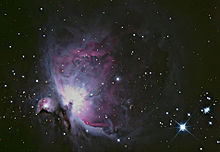
Single images
Thanks to digital photography, large numbers of images can be captured and stored. This means that they can easily be further processed at a later point in time.
As a rule, however, it takes longer for image processing than for the recordings.
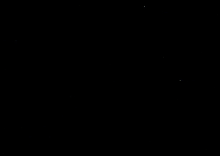
Modern image sensors can record rapid sequences of individual images of the night sky, for example to track satellites or falling stars .
Composition of picture series
techniques
Thanks to digitization, astrophotography has made great strides in the amateur field. The recording of series of images and their subsequent processing in the computer result in images that could previously only be made by large observatories. These images combine several different recording techniques, including the merging of images with different exposures ( exposure blending , exposure fusion ).
A digital result image ideally consists of a whole series of individual recordings. If possible, the camera generates images in raw data format (RAW) instead of JPEG format, since RAW files with 12 to 14 bits of color depth per color channel can store considerably more color gradations (and thus levels of brightness) than JPEG, which is only 8 bits per channel Color channel is limited. The images are then processed further as TIFF , which supports a sufficiently high color depth, or professionally in the FITS format. It should also be noted that with a high exposure index (ISO number) you can take photos of weaker celestial objects, but this reduces the dynamic range , which can be problematic for post-processing on the computer.
The recordings consist of:
- the actual photos of the night sky ( light frames ). The same section of the sky or the same star field is photographed several times . 5 to 20 recordings are required, but up to 100 recordings - sometimes spread over a few nights - are not uncommon.
- several dark frames ( dark frames ); 10 to 20 exposures are required. These are made with the same camera settings and at the same outside temperature , but the telescope is covered or an opaque filter is inserted. These dark images are later combined with one another in the computer to form a master dark and its content is deducted from each photo. The digital cameras only show their internal defects such as hot pixels and the sensor glow on dark images ; the heated camera electronics illuminate parts of the sensor from behind with their infrared radiation. These errors are also contained in the photos and are calculated out of them.
- Bias frames (also offset frames ); 10 to 20 exposures are also required. This is a series of dark photos that is taken with the shortest possible shutter speed and the same exposure index as the photos. It is used to remove that sensor noise that is dependent on the selected exposure index. The shortest possible exposure time is chosen to exclude other influences.
- Flat frames ; 10 to 20 exposures are also required. These are again photographs, but taken against an evenly brightly shining surface. With these recordings, vignetting and visible dust deposits in the system can be eliminated. The exposure time is chosen so that a bright, but not overexposed image is created. Otherwise, the same conditions apply as for the bias frames. Neither the camera position on the telescope nor the focus may be changed for these recordings.
A computer program now calculates these images with one another and uses them to create the resulting image.
panorama
image editing
The captured and combined images are aesthetically adjusted with image editing programs.
Also, light pollution and disturbing part of cloudiness can by the image plane is duplicated in the graphics program are subsequently removed, and an image plane with the Gaussian blur is processed. With a sufficiently large soft focus radius, the objects that you want to keep in the picture disappear. However, if you subtract the blurry layer from the original, the light pollution is removed. However, dimly glowing celestial objects are not restored.
hardware

Astrophotographic hardware for amateur use varies greatly, as the subjects range from aesthetic photography to semi-professional work. The amateur astrophotographer is confronted with challenges that can differ greatly from those of professional astronomers and conventional photography.
Since most people live in light pollution in urban areas , astronomical equipment must be portable to use outside the lights of big cities. Urban astrophotographers use special narrow-band filters and sophisticated digital image processing to remove interfering light from the background of their images. Alternatives are setting up a remote-controlled telescope in a location with a dark sky, or limiting it to bright objects such as the moon or planets. Challenges are also the alignment of portable telescopes for precise tracking , the limitation of mass-produced equipment and its service life, or manual tracking in long-term photography of astronomical objects and under variable weather conditions.
Lenses with manual focus are preferable, as the camera's autofocus often fails in low-light and low-contrast image sections. In addition, lenses with a high light intensity allow shorter exposure times, on the other hand, lenses with a high light intensity are more difficult to focus. Modern digital cameras offer focusing aids in live view , such as focus peaking , software magnifying glass , brightness amplification or calibrated distance scales, both on a screen and in an electronic viewfinder .
Some astrophotographers build a so-called barn door tracker , a simple device made of two wooden boards, a hinge and a thread, which enables the camera to be tracked and thus to compensate for the rotation of the earth.
Some camera manufacturers modify their products for astrophotography, such as the Canon EOS 60Da . It is based on the EOS 60D, but has a modified infrared filter and a low-noise sensor with increased H-alpha sensitivity for better images of red hydrogen emission nebulae .
There are also cameras specially developed for amateur astrophotography, such as the Tiny1 from the Singapore-based startup company TinyMOS .
Some amateurs use special webcam models with high sensitivity, for example manual focus cameras that contain old CCD sensors instead of the newer CMOS arrays. The objective lenses are removed and the camera is connected directly to the telescope to take pictures or videos. In the case of very weak objects, videos are recorded over a certain period of time and then combined to form a sharp image (see also stacking ). Such webcams preferred by astrophotographers are, for example, Philips PCVC 740K and SPC 900.
Sun photography
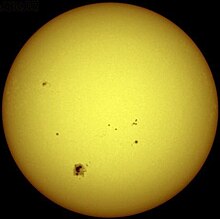

The photography of the sun is a special case of astrophotography, because with this motif you usually have too much light available. You almost always need a filter. Exceptions are:
- the photography of the low sun
- when haze severely weakens sunlight
- the corona during a total solar eclipse.
For visual observation of the unclouded sun or for photography with powerful instruments, special glass filters or aluminum-coated foils of strength ND 5, transmission 0.00001, or ND 6, transmission 0.000001 are attached in front of the lens. Newer products of the sun filter films are vapor-coated on both sides and can be used visually without hesitation. Filters of strength ND 4, transmission 0.0001, are only used for photographing the sun with high magnification through eyepiece projection or with aperture ratios of about 1:20 and short exposure times of around 0.001 s.
literature
- Klaus P. Schröder: Practical manual astrophotography - a guide for amateur astronomers. Franckh-Kosmos, Stuttgart 2003, ISBN 3-440-08981-9
- Wolfgang Schwinge: The cosmos manual astrophotography - equipment, technology, photo practice. Franckh-Kosmos, Stuttgart 1993, ISBN 3-440-06739-4
- Tony Buick: How to photograph the moon and planets with your digital camera. Springer, London 2006, ISBN 978-1-85233-990-6
- Michael A. Covington: Digital SLR astrophotography. Cambridge Univ. Press, Cambridge 2007, ISBN 978-0-521-70081-8
- Jeffrey R. Charles: Practical astrophotography. Springer, London 2000, ISBN 1-85233-023-6
- David Malin: A look into space. New pictures from the cosmos. Franckh-Kosmos Verlags-GmbH & Co., Stuttgart 1994. ISBN 3-440-06905-2 .
- Stefan Seip: digital astrophotography. Franckh-Kosmos Verlags-GmbH & Co. KG, Stuttgart 2006. ISBN 3-440-10426-5
- David Malin: The Invisible Universe. Nicolaische Verlagsbuchhandlung Beuermann GmbH, Berlin 2000. ISBN 3-87584-022-4
- Stefan Seip: Sky photography with the digital reflex camera. Franckh-Kosmos Verlags-GmbH & Co. KG, Stuttgart 2009. ISBN 978-3-440-11290-8
Web links
- Sonneberg Photo Plate Archive (Sonneberg Observatory)
- Experiments with plate scans from Sonneberg (by Béla Hassforther)
- Excellent astrophotos by EE Barnard from 1905
See also
Individual evidence
- ↑ David Malin: View into space . Franckh-Kosmos Verlags-GmbH & Co, Stuttgart 1994 ISBN 3-440-06905-2 . P. 18
- ↑ http://deepskystacker.free.fr/german/index.html
- ↑ https://photo.stackexchange.com/questions/26178/what-can-be-used-to-fight-light-pollution-in-astrophotography/83309

